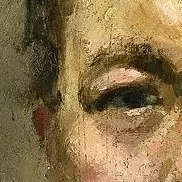Aside
For an extra boost to your enjoyment, consider listening to (Rimsky-Korsakov 2nd Symphony, Antar, movement 1: Vengeance)[https://youtu.be/Qd80g7wJWuQ?si=aZoRQ8PcU3_9OR_c]. This was the music that the artist listened to as he created the piece.
Ivan the Terrible and his son
A very sad piece indeed. Ivan the terrible’s mental illness came to a horrible climax one night when he saw his son’s pregnant wife walk by in a nightgown that exposed her under garments. Blind with rage, he struck his son in the head fataly.
The painting depicts Ivan the Terrible, stricken with grief and anguish as his son dies. The son, in tears, forgiving his father in some cosmic understanding as he lay dying.
On the surface, an example of how mental illness, left to take more and more control, can result in horrible consequences.
However, looking at the dates; the event occurred about 300 years before the painting was created. Why?
The political environment
The painting is an allegory of the assassination of Alexander II. Or rather the atrocity of the action itself and the consequences.
A group of far-left terrorists, bent on removing the autocratic tsarist government, killed A2 with a bomb in 1881; influenced by “Propaganda by the Deed,” hoping it would spark a revolution.
The painter not only witnessed the assassination, but also the hanging a few months later of the men who committed the act. He was horrified by the violence, he called them horrors of the contemporary world.
Aftermath
The act of terrorism failed and it would not be for another nearly 40 years, when things had gotten so bad and the tsars so weak that the Bolsheviks were able to succeed and establish a Soviet Republic, but only after killing basically everyone that knew how to do anything: Doctors, Lawyers, Farmers, etc. Leaving the country in tatters and the government free to be run by one person, who would go on to commit awful such atrocities that it made the whole history of the tsars look like childs play in comparison.


Your comment really doesn’t paint an accurate picture. I don’t thin op is right, but I don’t think you’re totally correct either. The life expectancy in Russia increased after the Bolshevik revolution because it had been decimated by disease, and a civil war for the years before that. The increase in life expectancy had nothing to do with communists coming into power. It certainly had nothing to do with industrialization that didn’t really get going in Russia until 1930. It had everything to do with the end of the civil war and global medicine advancing.
“Dire food shortages, hunger and famine were further exacerbated by the outbreak of several epidemics. Between 1918 to 1922 there were 2.5 million deaths as a result of the typhus epidemic…
Population figures fell by 35 million and were estimated at 139 million in 1921, a direct result of the war, famine and epidemic diseases.”
Source: https://www.sochealth.co.uk/2017/05/26/health-reform-revolutionary-russia/
Another source: Life expectancy (from birth) in Russia, from 1845 to 2020 - https://www.statista.com/statistics/1041395/life-expectancy-russia-all-time/